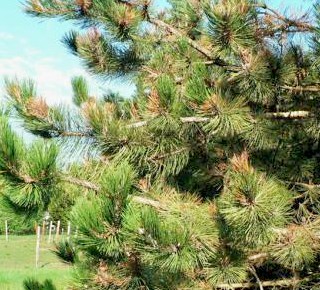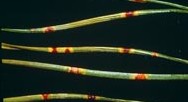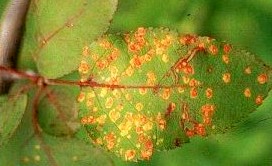Sphaeropsis (Diplodia) Tip Blight of Pines

Dead, brown needles at the tips of pine branches may signal the presence of Diplodia tip blight. Surveys indicate that no species of pine (Pinus) is immune to this disease, although some species are more severely affected than others. Austrian pine (Pinus nigra) is one of the most severely damaged species in Nebraska. Tip blight infection year after year can weaken and even kill large Austrian pine trees. Infection of new shoots can be reduced significantly by applying fungicide to pines during a period in late April and early May when shoots are highly susceptible to infection.

Dothistroma needle blight
Dothistroma needle blight is a common fungal disease that causes browning of needles of Austrian, ponderosa, and mugo pines. Fungicide sprays may be used if symptoms are found. Sprays should be applied twice in the spring after new growth appears, once in mid-May and again 4 to 6 weeks later.

Cedar Apple Rust and Apple scab
Cedar apple rust is caused by a fungal pathogen. This fungus attacks crabapples and apples and eastern red cedar. Apple scab is one of the most important diseases of apples and crabapples in Nebraska. It causes decreased yield, lower fruit quality, thin tree canopies and reduced tree vigor. Nearly every year, the disease defoliates susceptible varieties of ornamental crabapple. Fungicides can be applied to apple or flowering crab in the spring to reduce damage from these diseases. We are using a fungicide that has given exceptional results on this problem.

Dead, brown needles at the tips of pine branches may signal the presence of Diplodia tip blight. Surveys indicate that no species of pine (Pinus) is immune to this disease, although some species are more severely affected than others. Austrian pine (Pinus nigra) is one of the most severely damaged species in Nebraska. Tip blight infection year after year can weaken and even kill large Austrian pine trees. Infection of new shoots can be reduced significantly by applying fungicide to pines during a period in late April and early May when shoots are highly susceptible to infection.

Dothistroma needle blight
Dothistroma needle blight is a common fungal disease that causes browning of needles of Austrian, ponderosa, and mugo pines. Fungicide sprays may be used if symptoms are found. Sprays should be applied twice in the spring after new growth appears, once in mid-May and again 4 to 6 weeks later.

Cedar Apple Rust and Apple scab
Cedar apple rust is caused by a fungal pathogen. This fungus attacks crabapples and apples and eastern red cedar. Apple scab is one of the most important diseases of apples and crabapples in Nebraska. It causes decreased yield, lower fruit quality, thin tree canopies and reduced tree vigor. Nearly every year, the disease defoliates susceptible varieties of ornamental crabapple. Fungicides can be applied to apple or flowering crab in the spring to reduce damage from these diseases. We are using a fungicide that has given exceptional results on this problem.
Diseases | Insect Pests | Birch and Pin Oak